
Health 'Insurance' at Sea: 1 2 3 4 5 6 7 8 9 10 11 12 13 Next>>
Health 'Insurance' at Sea During the Golden Age of Piracy, Page 8
Intermediate Health Care - Navy: Hospitals Ship Configuration
As explained in the previous section, one problem with the naval hospital ships was that they were not modified to serve as hospital ships until around 1703. This created problems for those serving on hospital ships. For example, two merchant ships hired for the Third Dutch War - John's Advice and Catherine - "proved to have unsatisfactory accommodation for both the surgeons and their patients."1
The sailors did have one experienced surgeon in their corner when it came to setting up
the hospital ships during the second and third Dutch wars - Surgeon General to the Fleet James

Artist: Peter Lely- Prince Rupert (1660s.)
Pearse. He advised that a hospital ship be staffed with a master-surgeon, three or four surgeon's mates, and two or three landsmen to function as cooks and nurses. Pearse also advised that the surgeon be given a locked store room for his medicines and instruments.2
However, most modifications to hospital ships did not come from above, they came from below. When surgeon Hugh Ryder was posted to the John's Advice in April of 1672 he brought his medical supplies with him. Yet "he found that nothing had been done to adapt the ship to its hospital role... He was given no storage space for his medical supplies and was refused two cabins for his four mates to share."3 (Clearly not all of Pearse's suggestions had been implemented.)
A week after being posted to the ship, Ryder reported to the Navy Office to request that orders to be given to remedy these things. Unfortunately, none of those requests were granted. The one suggestion the Navy Office agreed to was for "the cutting of gratings to allow for more ventilation between decks when the ship was crowded with patients" and that was only authorized because of the intervention of Prince Rupert, who was then a senior British naval commander.4
The storage problem didn't go away, however. A year later the Duke of York (eventual King James II) directed the Navy Office to "ensure 'some convenient room to be provided in each of his Maj. ships for the use of the Chyrurgion particularly for the safe keeping & more convenient disposing of the necessaries provided for the sick & wounded men'."5 This was not done because of Pearse's suggestion or Ryder's request, but because there was evidence of theft.
Some men had better luck recommending changes. James Christie, surgeon aboard the Jeffreys from 1702-8 suggested that live sheep and fowls be carried on board hospital
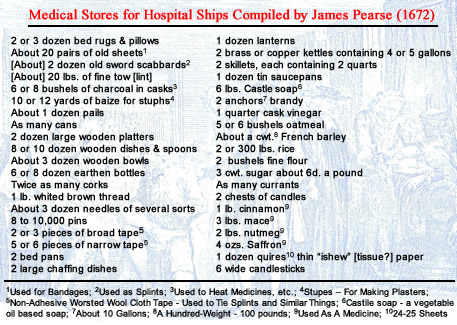
Image: The County Infirmary at Northampton, From the Wellcome Collection (1744)
vessels, to provide fresh meat for patients. This eventually became commonplace with mangers being located in the bows.6 Christie also advised that "sailors with infectious diseases should be moved to hospital ships straightway instead of being postponed until they were almost dead, as was the usual case."7
Ryder and Pearse were apparently instrumental in recommending supplies for hospital ships. Their list can be seen at right. "Hugh Ryder's experience, added to Pearse's own knowledge, led to the inclusion of all those small items whose omission bad caused such repeated demands and such distress among patients in the Loyal Katherine."8
The Barber-Surgeon's Company was responsible for supplying ships through William's War. While they don't provide a list quite as detailed as the one compiled by Pearse, their bill to the Navy for the outfitting of two hospital ships in 1694 for "£200 was stated to be for 'enabling them to provide Phisical Druggs, Medicaments, Neccessarys, Bedds, and other Conveniences for Sick and Wounded Seamen to be put on board the Society and Concord Hospitall Shipps now in the Streights'."9
Not everyone thought the medicines supplied were well chosen, however. Sea-surgeon Patrick Campbell,
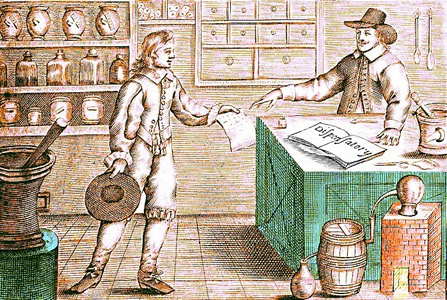
The Expert Doctor's Dispensary, by Pierre Morel, Wellcome Images, frontispiece (1657)
who had served on the hospital ships Ossory, Siam and Orford during his tenure with the navy during William's War said "hardly above one of twenty medicines in common use is otherwise necessary, but for Pomp, & the Apothecary sake"10. Keevil claims that this bias against the medicines supplied "was a prejudice shared by all naval surgeons against Apothecaries' Hall, the source of their supply."11 It may have also been due to personal preference. There are three lists of medicines recommended by/for sea-surgeons, including John Woodall's 299 medicines from 1617, John Moyle's 157 medicines from 1693 and John Tweedy's 118 medicines from 1743. The three lists only have 32 total medicines in common, suggesting that each surgeon had their own opinion about what medicine worked best at sea.12
It wasn't until Anne's War that the Navy grudgingly issued orders to modify the hospital ships according to requests made by the Sick and Hurt Commissioners in 1703. These orders
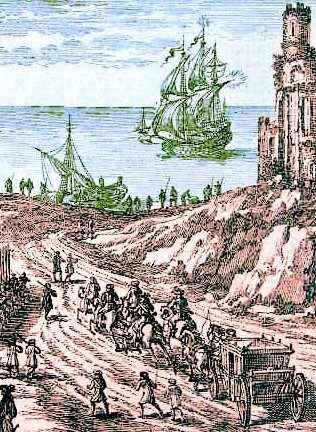
Meeting the Ship, From Description de l'univers,
by Alain
Manesson Mallet (1683)
provided more space to the patients by moving store rooms, cabins and the ship's company to the hold as mentioned previously. In addition, Sir George Byng and the Surveyor of the Navy "directed that 'no ship be hired unless the gun deck can be reserved entirely for accomodation of the sick'. Further orders called for extra scuttles for ventilation, the removal of bulkheads 'to make all flush', and the isolation of infectious cases by means of canvas screens."13
Additional improvements made to the ships in 1703 included the standardization of medicine chests, an increase in medical staff and the provision of sheets.14 The rules were set so that hospital ship medical crews included "a surgeon, four mates, eight assistants and 'a Boy to the Surgeon... [with] the ship's company [to be] ready to assist 'on extra occasions'"15. The surgeon was to have the use of the great cabins 'wholly to themselves' as well as having "conveniences made therein for their drugs and necessaries as they desired"16.
The surgeon was also more involved in fitting hospital ships during Anne's War. When the Martha and Leake were being readied for service, the work was "closely supervised by the surgeons who were to serve in them [Richard Gibson and Thomas Cooper], and involved the examination of samples and comparison of prices tendered by various tradesmen."17 The surgeons also "drew up lists of necessaries and discussed their needs with 'the rest of the Tradesmen as Tinman, Brasier, Turner and Grocer' whom they met at the hall and 'hastened in preparing the utensills they respectively submyt'."18
1 J.D. Davies, Pepys's Navy: Ships, Men and Warfare 1649-89, 2008, p. 62; 2 John J. Keevil, Medicine and the Navy 1200-1900: Volume II – 1640-1714, p. 125; 3 Kevin Brown, Poxed and Scurvied: The Story of Sickness and Health at Sea, p. 59; 4,5 Keevil, p. 125; 6 Keevil, p. 276; 8 National Museum of the Royal Navy, "Hospital Ships", Information sheet no 116, 2014; 9 Keevil, p. 257; 10,11 Keevil, p. 245; 12 For more detailed analysis of these lists, see The Sea Surgeon's Dispensatory, page 10; 13 Keevil, p. 241; 14 Keevil, p. 245; 15,16 Keevil, p. 243; 17,18 Keevil, p. 246
Intermediate Health Care - Navy: A Brief Case Study
By now it is probably clear that the navy had a wide variety of methods for providing intermediate health care. So many, in fact, that is worth briefly reiterating them. The Sick and Hurt Commission was set up by the Navy specifically to coordinate all the various programs for treating those with any health challenge received during their service. Lodging, usually land-based, was provided to men to allow for healing. This sometimes included temporary lodging in the form of tents and triage units, although this was not the usual choice. Men were more often put into permanent quarters including local houses, local hospitals, the London-based public hospitals and wartime established naval hospitals. The navy also supplied hospital ships beginning with the Second Dutch War, with their number increasing in each successive war.

Artist: Thomas Murray - William Dampier (c. 1697-8)
An example bears some of these things out. Well known privateer William Dampier talked about his experience after becoming sick while serving on a Naval vessel in the Third Dutch War. His treatment highlights how various programs could work in concert to help an ill sailor regain his health. It seems appropriate to finish this section with Dampier's report.
I listed my self on board the Royal Prince, Commanded by Sir Edward Sprague, and served, under him in the Year 1673, being the last of the Dutch Wars. We had three Engagements that Summer; I was in two of them, but falling very sick, I was put a board an Hospital Ship a day or two before the third Engagement, seeing it at a distance only; and in this Sir Edward Sprague was kill'd. Soon after I was sent to Harwich [where a wartime naval hospital was set up], with the rest of the Sick and wounded: And having languished [there] a great while, I went home to my Brother [in Somersetshire - which would have been treated as private lodging] to recover my health.1
1 William Dampier, “Mr. Dampier’s Voyages to the Bay of Campeachy.”, Dampier’s Voyages and Descriptions, Vol II, 1700, p. 4-5
Intermediate Health Care - Pirates & Buccaneers
We do not have much information on how the pirates handled intermediate health care after
they were 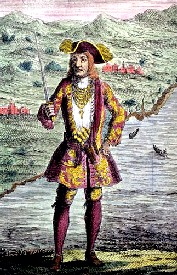
Bartholomew Roberts (1724)
wounded or became ill. This is due in large part to the limited amount of primary source information on the day-to-day lives of the pirates. However, as historian Ed Fox notes, "no absolutes apply to pirates."1
A factor here was the temporary structure of their groups. Unlike the merchant or navy plans, which were created (theoretically, at least) to last in perpetuity, pirates often lived more for the moment, knowing if they were caught, they would be hung. As pirate captain Bartholomew Roberts put it, "A merry Life and a short one, shall be my Motto."2 Roberts articles included a form of time limit on their crew; the first part of Article 9 states that "No man to talk of breaking up their way of living, till each had shared one thousand pounds."3 (Curiously, despite all these things, Roberts had one of the longest careers among the golden age pirates lasting four years - 1719-22.) Such a time-limited view of their organization might inspire less focus on prospects on how to deal with healing of sick and wounded men that lasted for longer periods. However, It is possible to piece some information about intermediate health care in the golden age of piracy world together from the material we have.

l'Ollonois Captures Gibralter in 1666 (1856)
While on raids, the buccaneers of the late 17th century sometimes put their wounded in buildings they had captured. When Henry Morgan took the Castle of Chagres in Panama in 1671, at least seventy of the buccaneers were wounded. "The wounded were carried to the church [in Panama], of which they made a hospital"4. Bartholomew Sharp attacked Arica, Chile in 1680 and the buccaneers put their wounded men and surgeons into a conveniently captured building, "that is to say, our hospital."5
At other times, the buccaneers put their wounded on ships. After taking Gilbraltar, Venezuela in 1666, Francois l'Olonnois' buccaneers chose to send "on board the fleet the wounded."6 When Captains Bartholomew Sharp, Peter Harris, John Coxon, Edward Cooke & Richard Sawkins captured Panama in 1680, they took a Spanish Vessel called La Santissima Trinidad (The Blessed Trinity) and they put their "wounded men on board her, and made her for the present our hospital."7
If the pirates were particularly lucky, they could find a sympathetic port where their sick and wounded men could be treated on an intermediate basis. Pirate captain John Bowen was able to lodge his ill and wounded in St. Thomas after the governor of the island "complimented him in a particular manner" when they shipwrecked on the island in 1701. Captain Johnson reported that "the sick men were got, with great care, into the fort, and cured by their doctor, and no supplies of any sort, wanting for the rest. They spent here three months"8.
Several of the golden age pirates (1690-1725) appear to have treated men shipboard. This is at least suggested by the number of pirates who were concerned with having a medicine chest on board. While medicines in a chest were sometimes used to treat wounds, they were more often used to treat illnesses. Thus it appears that pirates were often treated shipboard for illnesses. The importance of the medicine chest is emphasized in William Kidd's fourth article, which directed, "That the said ships company shall out of the first purchase taken after the victualling of the said ship is paid, pay for the surgeon's chest and all ships debts by the said voyage contracted."9
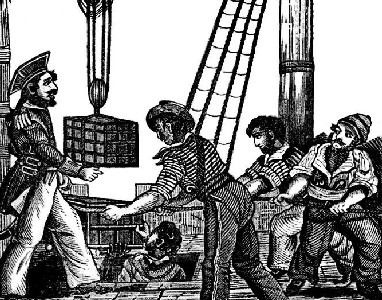
Loading a Chest, From The Pirate's Own Book by Charles Ellms (1837) Willing pirate surgeons Peter Scudamore and George Wilson both served in Bartholomew Roberts fleet. Each had a hand in stealing the medicine chests from captured ships. Scudamore took the medicine chests of the King Solomon and the Elizabeth. During his trial, he claimed that this was done under duress, protesting that fellow surgeon William Child (who had been acquitted) "had by the same Orders taken out a whole French Medicine-Chest"10. Scudamore was still found guilty. Wilson similarly protested that "to oblige his new Company, [he] had presently ask'd for the Pyrates Boat, to fetch the Medicine Chest away" from a captured ship.11
There are more extreme examples of pirates forcing their victims to provide them with medicine chests. Edward Low's pirates decided to hold two French ships for ransom, sending four of their crew "to make all haste to buy a doctor's chest at St. Thomas, about twelve leagues distant, swearing that if they didn't bring back the chest the other sloop should be burnt and the rest of the Frenchmen killed."12
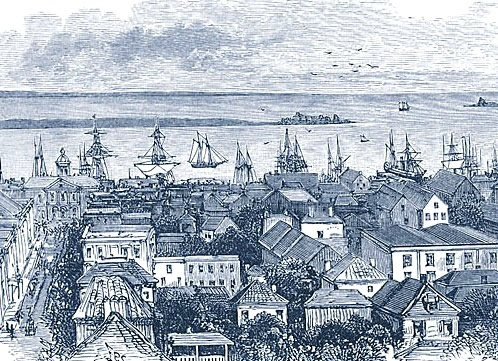
Artist: Ed Jackson Colonial Charles Town & Harbor, From Georgia Studies Image
More famously, Edward Teach held the port of Charleston hostage over a matter of medicine after taking several ships and barricading the harbor. Blackbeard was "threatning, that if they did not send immediately the Chest of Medicines, and let the Pyrate-Ambassadors [who had been sent to make the demand to] return, without offering any Violence to their Persons, they would murder all their Prisoners, send up their Heads to the Governor, and set the Ships they had taken on Fire."13
Of course, the presence of a medicine chest on board didn't necessarily mean it had to be used there. Medicine chests could also be used on shore if the pirates chose to land their sick and wounded men. While there are only a few example of pirates doing this, it was done. Pirate captain Nathaniel North was in Mayotta (part of Comoros), off of Africa, when "a sickness coming among them, they built huts ashore. They lost, notwithstanding all their care and precaution, their captain and thirty men, by the distemper which they contracted"14.
Another example of temporary shore-based lodgings occurred after George Lowther attacked the Amy while off the coast of North Carolina. "During the engagement he [Lowther] had a good many men killed 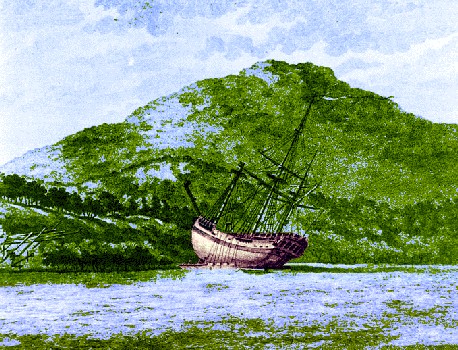
Artist: Sydney Parkison - Careening a Ship, (The Endeavor) (c. 1770) and wounded and all in all it seemed best to pull in to one of the many inlets on the North Carolina coast and refit and allow his wounded to recover."15 This took longer than expected, so they decided to winter there, setting up "their huts and tents near the sloop where they lodged during the winter"16.
There are no direct references to pirates putting men ashore to heal, which was a common practice of both the navy and merchants as we have seen. However, we do know at least one man on Roberts' crew was relieved of duty while healing. This came to light during the trial of James Skyrm, who was captain of the Ranger during Roberts' last battle. Skyrm had previously been 'drubbed' which 'broke his Head', as a result of which he had "for several Months past been sick, and disqualified for any Duty". He went on to say that "Roberts had forced him on this Expedition much against his Will."17 In addition to being relieved of duty, the fact that Skyrm claimed to be 'forced on the Expedition' suggests that he had not been on other expeditions while he was recovering and so was likely left on land while healing.
1 Ed Fox, Doctoral Thesis, 'Piratical Schemes and Contracts': Pirate Articles and Their Society, 1660-1730, University of Exeter, May 2013, p. 309; 2 Captain Charles Johnson, A general history of the pirates, 3rd Edition, p. 273; 3 Johnson, General History, p. 232; 4 Alexander Exquemelin, The History of the Buccaneers of America, 1856, p. 139; 5 Exquemelin, p. 261; 6 Exquemelin, p. 72; 7 Exquemelin, p. 201; 8 Johnson, History of the Pirates, p. 49; 9 Fox, p. 310; 10 Johnson, General History, p. 310; 11 Johnson, General History, p. 314; 12 George Francis Dow and John Henry Edmonds, The Pirates of the New England Coast 1630-1730, p. 202; 13 Johnson, General History, p. 73; 14 Captain Charles Johnson, The History of the Pirates, p. 191; 15 Dow and Edmonds, p. 136-7; 16 Dow and Edmonds, p. 137; 17 Johnson, General History, p. 305

